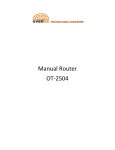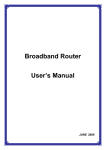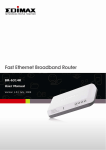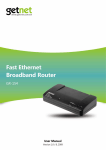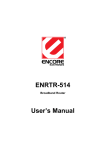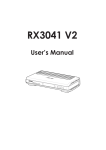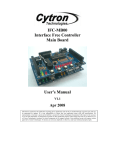Download AOpen 4-Port 10/100Mbps Ethernet Broadband Router User`s manual
Transcript
LKR-604 4-Port Broadband Router User's Manual Revision C 1 Contents 1 Introduction........................................................................................................................... 4 1.1 Features ................................................................................................................................. 4 1.2 Package Contents .................................................................................................................. 4 1.3 Finding Your Way Around ................................................................................................... 5 1.3.1 Front Panel ............................................................................................................................ 5 1.3.2 Rear Panel and Side Panel ................................................................................................... 5 2 PC Configuration .................................................................................................................. 7 2.1 Checking TCP/IP Settings for Windows XP ....................................................................... 7 3 Setup Router Configurations via Web Browser ................................................................. 8 3.1 Start your Web Browser ....................................................................................................... 8 3.2 Quick Setup ........................................................................................................................... 9 3.3 Admin .................................................................................................................................. 11 3.3.1 Management ........................................................................................................................ 11 3.3.2 System Settings.................................................................................................................... 12 3.3.3 Firmware Upgrade ............................................................................................................. 12 3.3.4 Configuration ...................................................................................................................... 13 3.3.5 Tools ..................................................................................................................................... 13 3.3.6 Language ............................................................................................................................. 14 3.3.7 Log Settings ......................................................................................................................... 14 3.3.8 Logout .................................................................................................................................. 15 3.4 WAN ..................................................................................................................................... 16 3.4.1 WAN Connection Mode ...................................................................................................... 16 Select properly Internet Connection type. .................................................................................. 16 3.5 LAN ...................................................................................................................................... 21 3.5.1 LAN Settings ....................................................................................................................... 21 3.5.2 DHCP Client List ................................................................................................................ 21 3.5.3 IGMP Snooping ................................................................................................................... 22 3.6 NAT ...................................................................................................................................... 22 3.6.1 Virtual Server ...................................................................................................................... 22 3.6.2 Port Triggering .................................................................................................................... 23 3.6.3 Port Mapping ...................................................................................................................... 24 3.6.4 Passthrough ......................................................................................................................... 25 3.6.5 DMZ ..................................................................................................................................... 25 3.7 Firewall ................................................................................................................................ 26 3.7.1 Firewall Options.................................................................................................................. 26 3.7.2 Client Filtering .................................................................................................................... 26 3.7.3 URL Filtering ...................................................................................................................... 27 3.7.4 MAC Filtering ..................................................................................................................... 28 3.8 Routing................................................................................................................................. 28 3.8.1 Routing Table ...................................................................................................................... 28 3.8.2 Static Routing ...................................................................................................................... 29 3.8.3 Dynamic Routing ................................................................................................................ 29 2 3.9 QoS ....................................................................................................................................... 30 3.10 Misc ...................................................................................................................................... 31 3.10.1 UPnP .................................................................................................................................... 31 3.10.2 DDNS ................................................................................................................................... 32 3.11 Status.................................................................................................................................... 32 3.11.1 Status .................................................................................................................................... 32 3.11.2 Log........................................................................................................................................ 33 3 1 Introduction Congratulations on purchasing Broadband Router. This router, is a high quality and reliable Internet routing device, enables multiple users to share the internet connection through a Cable or DSL modem. Simply install the router, connect to Cable/DSL modem, and surf Internet without extra efforts. Acting as a 10/100Mbps 4-port Ethernet switch as well, the router, with all ports supporting MDI/MDIX, allows you to use CAT5 cable to uplink to other routers/switches. The router provides a total solution for the Small and Medium-sized Business (SMB) and the Small Office/Home Office (SOHO) markets, giving you an instant network today, and the flexibility to handle tomorrow's expansion and speed. 1.1 Features Network Address Port Transmission (NAPT) support Supports PPPoE and PPTP protocol for Dial-Up ADSL Supports up to 253 users Supports UPnP (Universal Plug and Play) Supports DMZ and virtual server mapping Supports packet filtering Simple Firewall protection Upgradeable firmware for future functions Easy configuration via Web Browser. 1.2 Package Contents One LKR-604 4-Port Broadband Router One external power adapter One CD-ROM with User’s Manual One Quick Installation Guide One RJ-45 Ethernet Cable 4 1.3 Finding Your Way Around 1.3.1 Front Panel The front panel contains LED indicators that show the status of the unit. LED POWER Color Green WAN Green The WAN port is connected to an xDSL/Cable modem successfully. Green(blinks) The WAN port is transmitting data to or receiving data from the xDSL/Cable modem. Green The port 1 - 4 indicators light green when they’re connected to a 100Mbps Fast Ethernet station. Green(blinks) The corresponding LAN port is transmitting or receiving data. LAN(Link/Act) Indication Power in on, otherwise, power is off 1.3.2 Rear Panel and Side Panel The rear and side panel contain the ports for the unit’s data and power connections. 5 RESET LAN (1-4) WAN POWER Use a pin-shaped object to reset this device to factory default settings. Resetting the device will also reset the login password to the default. Four RJ-45 10/100Mbps Auto-MDIX ports for connecting to either 10Mbps or 100Mbps Ethernet connections. On the 4 port broadband router, there is an RJ-45 10/100Mbps Auto-MDIX WAN port. This port connects to your xDSL/Cable modem. Connects the supplied AC adapter to the power input jack. 1.4 System Requirements One or more PCs (desktop or notebook) with Ethernet interface. TCP/IP protocol must be installed on all PCs. Have valid Internet Access account and a DSL/Cable modem. 10/100BaseT Ethernet network cable with RJ-45 connector. System with Microsoft Internet Explorer 6.0 or higher. 1.5 Installation Instruction 1) 2) 3) 4) Power off the router and DSL/Cable modem. Connect systems to the LAN ports on the router with straight Ethernet LAN cables. Connect the DSL /Cable modem to the WAN port on the router. Power on DSL/Cable modem firstly, wait for a minute until the modem is ready then power on the router. 5) Check LEDs: a) Once power on the router, Power LED should be on. b) LAN LED should be on for each active LAN connection. c) The WAN LED should be on when the DSL/Cable modem is connected. 6 2 PC Configuration 2.1 Checking TCP/IP Settings for Windows XP a) Click “Start”, select “Control Panel → Network Connection” and right click “Local Area Connection” then select “Properties”, the window shown as below will appear. b) Select the “Internet Protocol (TCP/IP)” for the network card on your system, then click “Properties”, the window below will appear. If you decide to use IP address from the router, select “Obtain an IP address automatically”. If you decide to use the desired IP address, select “Use the following IP address”, and enter the 7 correct addresses in “IP Address” and “Subnet Mask” fields. You'd better set the router’s IP address as “Default Gateway”. If the DNS Server fields are empty, select “Use the following DNS server addresses” and enter the DNS address provided by your ISP, then click “OK”. 3 Setup Router Configurations via Web Browser The router comes with a web-based configuration utility. Users can access this configuration utility from any of client system within Broadband Router’s LAN. For best results, either use Microsoft Internet Explorer 6.0 or higher. Before you start configuring your router, you have to get the following information from your ISP: a) Has your ISP assigned you a static IP address, or they will assign one to you dynamically? If you have received a static IP address, what is it? b) Does your ISP use PPPoE? If so, what is your PPPoE username and password? If you are not sure of above questions, please contact your ISP. 3.1 Start your Web Browser To use the Web-Based Utility, you have to launch your Internet Explorer 6.0or higher. Step1: Enter the default IP address of Broadband Router http://192.168.0.1 in the Address box and then press Enter. Step2: When the follwing dialog box appears, type in admin as User Name and the default password is also admin, then click OK. 8 3.2 Quick Setup It is recommended that you use Quick Setup if you are a beginner. It will lead you through the configuration step-by-step. Step1: Select the appropriate Time Zone so your system clock can synchronize itself through the SNTP Server. Host Name: Enter a hostname provided by the ISP (Default: router). Time Zone: Select the time zone of the country you are in. The router will set the time based on your selection. Daylight Saving: The router can also take Daylight Saving into account. If you wish to use this function, you must check/tick the enable box to enable your daylight saving configuration. Fuction Mode: Default setting is Router. Step2: The following window allows user to specify the WAN connection type, you can choose Auto Detect or Manual Select. Auto Detect: This feature can help you Auto Detect WAN connection type. Manual Select: You can specify the WAN connection type. 9 Step3: The following window allows user to specify the WAN connection type, such as Dynamic IP Address, Static IP, or PPPoE. After you setup the connection settings, click Next to update the DNS settings. Dynamic IP Address: Automatic access to service provider offer dynamic IP addresses to network. Static-IP: If you are using fixed IP Internet connection method, click static-IP to enter the IP address and gateway address provided by your ISP. PPPoE: If you are using PPPoE Internet connection method, click PPPoE to enter the login information provided by your ISP. PPTP: If you are using PPTP Internet connection method, click PPTP to enter the login information provided by your ISP. L2TP: If you are using L2TP Internet connection method, click L2TP to enter the login information provided by your ISP. BigPond: If you are using BigPond Internet connection method, click BigPond to enter the login information provided by your ISP.( BigPond is an ISP in Australia) Step4: The following window allows user to select the DNS Server. You can update the DNS settings only if you enabled the DNS server under the WAN configuration page. After you change the DNS configurations, click Finish to update the DNS settings of the router. Click the Finish button will be submitted to the router and set down effect. In the configuration of the status bar, you can view the information about the router. The router-related information is in the next chapters. 10 3.3 Admin The Admin window configures the Management of the router basic settings, such as the router’s Management, System Settings, Firmware Configuration, Tools, Language, Log Settings and Logout. 3.3.1 Management Login Account Set a password if you wish to restrict management access to the Broadband Router. Remote Management To manage the Broadband Router from a remote location (outside of the local network), you must specify the IP address of the remote PC. Leave the IP address as 0.0.0.0, to allow open access to the router. 11 3.3.2 System Settings NTP Server: Set the router to the Internet through the NTP protocol to obtain the correct time and maintained. Time Zone: Select the time zone of the country you are in. The router will set the time based on your selection. Daylight Saving: The router can also take Daylight Saving into account. If you wish to use this function, you must check/tick the enable box to enable your daylight saving configuration. Host Name: Enter a hostname provided by the ISP NAPT: Multiple internal addresses mapped to a valid public address, but different protocols and port numbers corresponding to different internal addresses. Function Mode: Default setting is Router. 3.3.3 Firmware Upgrade User uses the Firmware Upgrade window to locate the new firmware then upgrade the system firmware. Click "Choose File" button to search for the new firmware location, then click OK to proceed the upgrade. 12 3.3.4 Configuration Use this window to restore or backup Broadband Router settings, such as Restore Factory Default, Backup Settings and Restore Settings. Restore Factory Default: Reset the settings of this device to the factory default values. Backup Settings: Save the settings of this device to a file. Restore Settings: Restore the settings of this device to the backup settings. 3.3.5 Tools Restart Device: Reboot this device. 13 3.3.6 Language You can choose English or Traditional Chinese. 3.3.7 Log Settings The log is very important for network safety, it recorded a variety things of system every day, you can check the error occurred, or track the Internet traffic. Remote Log: Allow remote login View Log. Log Server: Type the IP address of Log Server. Email log: Check to enable the email log feature. Send Email: Click on the "Send" button to send the mail immediately. . Sender Email Address: Enter the sender email address. Receiver Email Address: Enter the receiver email address. SMTP Server: Enter outgoing mail server. Enable Authentication: Check if need for authentication. . Account Name: Fill in email user account name. Password: Enter password. Re-type Password: Re-enter the above password. 14 3.3.8 Logout If want to logout, please click OK. 15 3.4 WAN 3.4.1 WAN Connection Mode Select properly Internet Connection type. 1 Dynamic IP Address The Host Name is optional, but may be required by some ISPs. The default MAC address is set to the WAN's physical interface on the router. Use this address when registering for configuration parameters for the selected connection type. The MTU feature specifies the largest packet size permitted for network transmission. By default, MTU is set at 1500. You can use the "Clone MAC" button to copy the MAC address of the Ethernet Card installed by your ISP and replace the WAN MAC address with this MAC address. 16 2 Static IP If your Internet Service Provider has assigned a fixed address, enter the assigned IP address and subnet mask, then enter the gateway and DNS address. 17 3 PPPoE (PPP over Ethernet) Enter the PPPoE user name and password assigned by your Service Provider. The Service Name is normally optional, and may be required by some service providers. Enter a Maximum Idle Time (in minutes) to define a maximum period of time for which the Internet connection is maintained when it is inactive. If the connection is inactive for longer than the defined Maximum Idle Time, then it will be dropped. You can enable the Auto-reconnect option to automatically reestablish the connection as soon as you attempt to access the Internet again. 18 4 PPTP (Point-to-Point Tunnel Protocol) The PPTP window allows user to configure basic PPTP settings for the router. PPTP is dial-up used to establish a virtual private network (VPN) approach, which needs three parts of information. First is the WAN port's IP address and subnet mask. The second is to connect back to the PPTP server IP address. The third is the dial-up user name and password. 19 5 L2TP The L2TP window allows user to configure basic L2TP settings for the router. 6 Big Pond The Big Pond window allows user to configure basic BigPond settings for the router. ( BigPond is an ISP in Australia) 20 3.5 LAN 3.5.1 LAN Settings Configure the gateway address of the router. To dynamically assign the IP address for clients' PCs, enable the DHCP Server, set the lease time, and then specify the address range. Valid IP addresses consist of four numbers, which are separated by periods. The first three fields are the network portion ranging from 0 to 255, while the last field is the host portion ranging from 1 to 254. IP address: This is the router’s LAN port IP address (Your LAN clients' default gateway IP address). Subnet Mask: Specify a Subnet Mask for your LAN segment. The Gateway acts as DHCP Server: Check to enable the DHCP server. IP Pool Starting Address: Enter the first IP address assigned by the DHCP server. IP Pool Ending Address: Enter the last IP address assigned by the DHCP server. Lease Time: Enter the amount of time that a client can use the assigned IP address. DNS Proxy: Check to enable the DNS Proxy. 3.5.2 DHCP Client List The DHCP client list allows you to see which clients are connected to the router via IP address, host name, and MAC address. 21 DHCP Client List: This page shows all DHCP clients (LAN PCs) currently connected to your network. It displays the IP address and the MAC address and Remaining Time of each LAN client. Use the Refresh button to get the lately updated situation. 3.5.3 IGMP Snooping Allowing switched Ethernet to check and make correct forwarding decisions. 3.6 NAT 3.6.1 Virtual Server If you configure the router for a virtual server, remote users access services such as Web or FTP at your local site from internet the traffic can be automatically redirected to local servers configured as the virtual server. In other words, depending on the requested service (TCP/UDP port number), the router redirects the external service request to the appropriate server. 22 Enabled: Enable Virtual Server. Private IP: This is the LAN client/host IP address being used by the virtual server within your local network. Private Port: This is the LAN client/host port number being used by the application on the computer within your local network. Public Port: Enter the service (service/Internet application) port number that will be re-directed to the virtual server on your local network. Type: Select the Internet protocol type (TCP, UDP or both). If you are not sure, leave it to be the default both protocols. Comment: The description of this setting. 3.6.2 Port Triggering Some applications require multiple connections, such as Internet gaming, video conferencing, Internet telephony and others. These applications cannot work when Network Address Translation (NAT) is enabled. If you need to run applications that require multiple connections, specify the port associated with an application in the "Trigger Port" out going port field, select the protocol type as TCP or UDP, then enter the public ports incoming port associated with the trigger port to open them for inbound traffic. 23 3.6.3 Port Mapping This function allows one or more public IP addresses to be shared by multiple internal users. Enter the Public IP address you desire to share into the Global IP field. Enter a range of internal IP that will share the global IP. 24 3.6.4 Passthrough VPN: VPN including PPTP, IPSEC and L2TP, if checked, the internal network and external network can directly establish a corresponding VPN services, without NAT affect FTP: FTP server with non-standard port, can prevent the conflict which has established a connection with fit data channel NetMeeting: The internal network NetMeeting services establish connections directly with external network NetMeeting services, without NAT affect 3.6.5 DMZ If you have a client PC that cannot run Internet application properly from behind the NAT firewall or after configuring the Special Applications function, then you can open the client up to unrestricted two-way Internet access. Enter the IP address of a DMZ host to this screen. Adding a client to the DMZ (Demilitarized Zone) may expose your local network to a variety of security risks, so you can only use this option as a last resort. 25 3.7 Firewall 3.7.1 Firewall Options The router provides extensive firewall protect by restricting connections to reduce the risk of intrusion and defending against a wide array of common hacker attacks. However for applications that require unrestricted access to the Internet, you can configure a specific client/server as a demilitarized zone. Firewall Options Select the functions that firewall supports. The selections include Enable Hacker Attack Protect ,Discard PING from WAN side, Deny PING to the Gateway, Drop Port Scan packets, Allow to Scan Security Port (113),Discard NetBIOS Packets, Accept Fragment Packets and Send ICMP Packets When Error is Encountered. 3.7.2 Client Filtering You can filter Internet client based on IP addresses, port, application types, and time of day. For example, this screen shows that clients in the address rang 192.168.0.2-4 are permanently restricted from using WEB(Port 80) are blocked from browsing the Internet from Monday through Friday. 26 IP Address: Enter the starting/ending IP address. Port: Enter the port range based over the protocol for access policy. Type: Select one protocol (TCP/UDP/Both) from the drop-down menu. Block Time: Always or manually set the filter time. Day: Select the day(s) to run the access policy. Time: Select the time range of client filter. Comment: You can add some comment for this item. 3.7.3 URL Filtering To configure the URL Filtering feature, please specify the web sites and/or web URLs containing the keyword you want to filter on your network. You can deny or allow Internet access for the URL addresses. For example, in this screen you can see that clients in the address rang 192.168.0.100-200 are unable to browsing the sites (www.google.com). 27 3.7.4 MAC Filtering The MAC address filter enables you to allow or restrict specified nodes from communicating with other nodes. MAC Address Control: The device's MAC address that you want to filter. Comment: You can add some comment for this item. 3.8 Routing 3.8.1 Routing Table The Routing Table window displays the current routing information in the system. 28 3.8.2 Static Routing A static route is a pre-determined pathway that network information must travel to reach a specific host or network. Destination Network IP: The network address of destination network. Subnet Mask: the subnet mask of destination network. Gateway IP: The next stop gateway of the path toward the destination network. This is the IP of the neighbor router that this router should communicate with on the path to the destination network. 3.8.3 Dynamic Routing Dynamic Routing can be used to cache routes learned by routing protocols, thus allowing the automation of static routing maintenance. The router, using the RIP (Routing Information Protocol), determines the network packet’s route based on the fewest number of hops between the source and the destination. In this case, you can automatically adjust to physical changes in the network layout. 29 Working Mode: Select the router acts as router of gateway. Listen Mode: Enable this mode to allow RIP server to receive routing information and update the routing information. Supply Mode: Enable this mode to allow RIP server to send out routing information and update the routing information. 3.9 QoS QoS (Quality of Service) is a major issue in VOIP implementations. The issue is how to guarantee that packet traffic for a voice or other media connection will not be delayed or dropped due interference from other lower priority traffic. Port Base: In order to complete this settings, please follow the steps below. Enable this function. Select the port number. Enter the total speed with the port number. Click OK button to add this item to control table. DSCP Base: DSCP replaces the outdated IP precedence, a 3-bit field in the Type of Service byte of the IP header originally used to classify and prioritize types of traffic 30 3.10 Misc 3.10.1 UPnP UPnP (Universal Plug and Play) allows automatic discovery and configuration of equipment attached to your LAN. UPnP is supported by Windows ME, XP, or later. It provides compatibility with networking equipment, software and peripherals of over 400 vendors the cooperate in the Plug and Play forum. You can Enable or Disable UPnP feature here. 31 3.10.2 DDNS DDNS (Dynamic DNS) provides you on the Internet with a method to tie their domain name to a computer or server. DDNS allows your domain name to follow your IP address automatically by changing your DNS records when your IP address changes. 3.11 Status This section displays the basic configuration parameters of your router, such as System Status, System Settings, Administrator Settings, Firmware Upgrade, Configuration Tools and System Log. Although most users will be able to accept the default settings, every ISP is different. Please check with your ISP if you are not sure which settings the ISP requires. 3.11.1 Status You can use the Status screen to see the connection status for the router's LAN interfaces, firmware and hardware version numbers, and the number of connected clients to your network. 32 3.11.2 Log The System Log window displays the router’s system activities, such as System Log and Security Log. 33 34



































